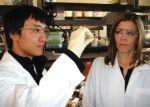Diabetes affects the lives of millions of Americans, young and old alike, on a daily basis.
According to the American Diabetes Association, more than 25 million children and adults in the United States have been diagnosed with diabetes, along with an estimated 79 million people who were said to have shown pre-diabetic symptoms.
The current and most common method of monitoring glucose levels is by taking finger prick tests, in which a blood sample is drawn and placed on a strip inside a glucose meter. Diabetic patients are encouraged to do this at least four times a day. Many patients dont follow this procedure, however, because it is uncomfortable or they simply forget.
Melissa Grunlan, associate professor of biomedical engineering at Texas A&M, has lofty goals for creating a more efficient way of monitoring glucose levels for children and adults with diabetes. The object is to create a self-cleaning membrane to be placed around an implanted glucose sensor.
When you implant a glucose sensor subcutaneously, the body has a natural defense mechanism that would see the sensor coming in and know it didnt belong there, Grunlan said. It would send in cells that would cut off the sensor from the rest of the body. This usually happens within a week.
Grunlan is working with Gerry Cot, professor and department head of biomedical engineering, who is helping to develop the sensor while Grunlan and her team develop the protective membrane. Graduate students and undergraduates are also involved in the research.
What we are trying to do is develop a biosensor [to monitor glucose levels] that the body would accept and not reject when it is implanted in the body, Grunlan said. We came up with the idea for a self-cleaning membrane to wrap around the sensor.
Grunlan said the membrane is made of a hydrogel material, is similar to that of a contact lens. This self-cleaning membrane would allow the sensor to work for long periods of time.
She said the membrane that would be wrapped around the sensor would also be thermo-responsive, meaning when the membrane is heated, it would collapse and when cooled it would swell. The diabetic patient would then wear a watch-like device that would monitor their glucose level while at the same time serving as a heating device that would be able to slightly heat the skin, causing the membrane surrounding the sensor to collapse.
That process would clean cells and proteins off the biosensor, extending its reliability over time.
Ruochong Fei is a biomedical engineering graduate student working with Grunlan on this project. He is using this study for his doctoral dissertation topic and works on preparation and material characterization for the self-cleaning membrane.
When I applied to graduate school, I immediately became enchanted with Dr. Grunlans research because it aligns with my research experience and interests, Fei said. It has been three and a half years since I started working on this project with her.
Fei is excited about the potential the membrane has for the future of diabetic patients.
I feel proud to be able to work on this project and hope that my research will provide small but crucial steps toward developing the full potential of this membrane and ultimately make a difference in this field, Fei said.
Kristen Means, senior biomedical engineering major, has also been a part of the team working to develop the membrane.
I was initially interested in this project because I have many family members suffering from diabetes and I wanted to make a difference, Means said. I hope eventually our sensor can be available to all these patients and make their lives easier and safer.
Grunlans students had nothing but high praises for her and her work.
She is tough, but fair. And shes passionate about her area of study, Means said. She is one of those people who motivates you to do better than your best.
The timeline for completion of the self-cleaning membrane is still uncertain, but Grunlan is hopeful the work the team will be seen and used in diabetic patients in the near future.
Self-cleaning membrane aids in diabetic research
January 22, 2013

Donate to The Battalion
Your donation will support the student journalists of Texas A&M University - College Station. Your contribution will allow us to purchase equipment and cover our annual website hosting costs.



















